Innovation and Commercialization Strategies in Organizations
VerifiedAdded on 2024/06/04
|22
|5142
|249
Report
AI Summary
This report examines the critical aspects of innovation and commercialization within organizations. It begins by differentiating between innovation and invention, highlighting the importance of innovation for organizational sustainability and competitive advantage. The report explores how organizational vision, leadership, culture, and teamwork shape innovation and commercialization processes. It analyzes various sources of innovation, including customers, competitors, and internal employees, and discusses methods to foster an environment conducive to innovation. Furthermore, the report delves into the 4Ps of innovation (Product, Process, Position, Paradigm) and the application of the innovation funnel. It also evaluates the role of frugal innovation and its application in organizational contexts, using the example of Healthy Juices. The report then discusses the commercial funnel and new product development (NPD) processes, along with building an innovation business case and accessing funding. Finally, it evaluates tools for developing, retaining, and protecting knowledge and intellectual property, emphasizing the importance of aligning innovation with customer needs and market developments.

Unit 8: Innovation and Commercialization
Paraphrase This Document
Need a fresh take? Get an instant paraphrase of this document with our AI Paraphraser
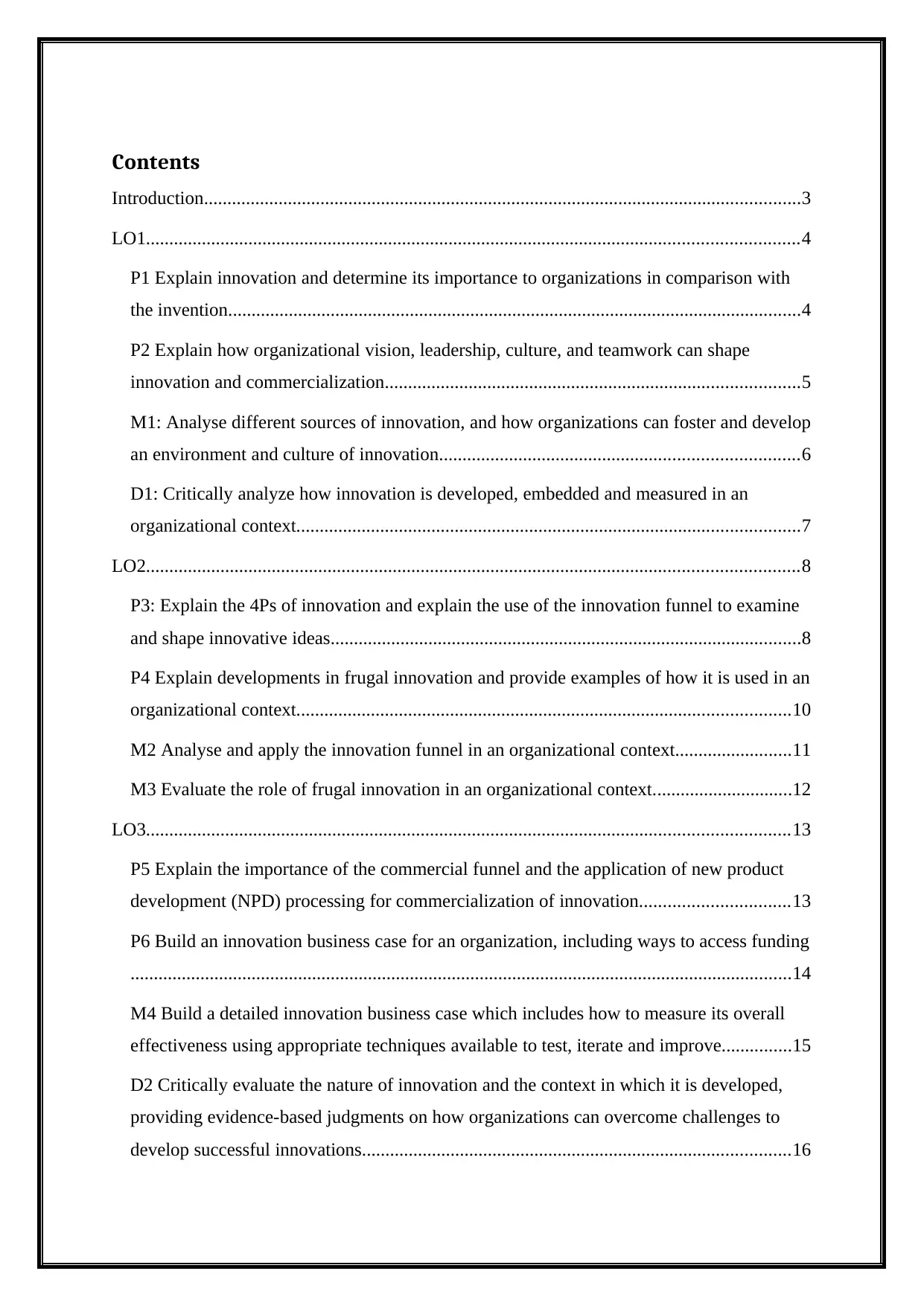
Contents
Introduction................................................................................................................................3
LO1............................................................................................................................................4
P1 Explain innovation and determine its importance to organizations in comparison with
the invention...........................................................................................................................4
P2 Explain how organizational vision, leadership, culture, and teamwork can shape
innovation and commercialization.........................................................................................5
M1: Analyse different sources of innovation, and how organizations can foster and develop
an environment and culture of innovation.............................................................................6
D1: Critically analyze how innovation is developed, embedded and measured in an
organizational context............................................................................................................7
LO2............................................................................................................................................8
P3: Explain the 4Ps of innovation and explain the use of the innovation funnel to examine
and shape innovative ideas.....................................................................................................8
P4 Explain developments in frugal innovation and provide examples of how it is used in an
organizational context..........................................................................................................10
M2 Analyse and apply the innovation funnel in an organizational context.........................11
M3 Evaluate the role of frugal innovation in an organizational context..............................12
LO3..........................................................................................................................................13
P5 Explain the importance of the commercial funnel and the application of new product
development (NPD) processing for commercialization of innovation................................13
P6 Build an innovation business case for an organization, including ways to access funding
..............................................................................................................................................14
M4 Build a detailed innovation business case which includes how to measure its overall
effectiveness using appropriate techniques available to test, iterate and improve...............15
D2 Critically evaluate the nature of innovation and the context in which it is developed,
providing evidence-based judgments on how organizations can overcome challenges to
develop successful innovations............................................................................................16
Introduction................................................................................................................................3
LO1............................................................................................................................................4
P1 Explain innovation and determine its importance to organizations in comparison with
the invention...........................................................................................................................4
P2 Explain how organizational vision, leadership, culture, and teamwork can shape
innovation and commercialization.........................................................................................5
M1: Analyse different sources of innovation, and how organizations can foster and develop
an environment and culture of innovation.............................................................................6
D1: Critically analyze how innovation is developed, embedded and measured in an
organizational context............................................................................................................7
LO2............................................................................................................................................8
P3: Explain the 4Ps of innovation and explain the use of the innovation funnel to examine
and shape innovative ideas.....................................................................................................8
P4 Explain developments in frugal innovation and provide examples of how it is used in an
organizational context..........................................................................................................10
M2 Analyse and apply the innovation funnel in an organizational context.........................11
M3 Evaluate the role of frugal innovation in an organizational context..............................12
LO3..........................................................................................................................................13
P5 Explain the importance of the commercial funnel and the application of new product
development (NPD) processing for commercialization of innovation................................13
P6 Build an innovation business case for an organization, including ways to access funding
..............................................................................................................................................14
M4 Build a detailed innovation business case which includes how to measure its overall
effectiveness using appropriate techniques available to test, iterate and improve...............15
D2 Critically evaluate the nature of innovation and the context in which it is developed,
providing evidence-based judgments on how organizations can overcome challenges to
develop successful innovations............................................................................................16
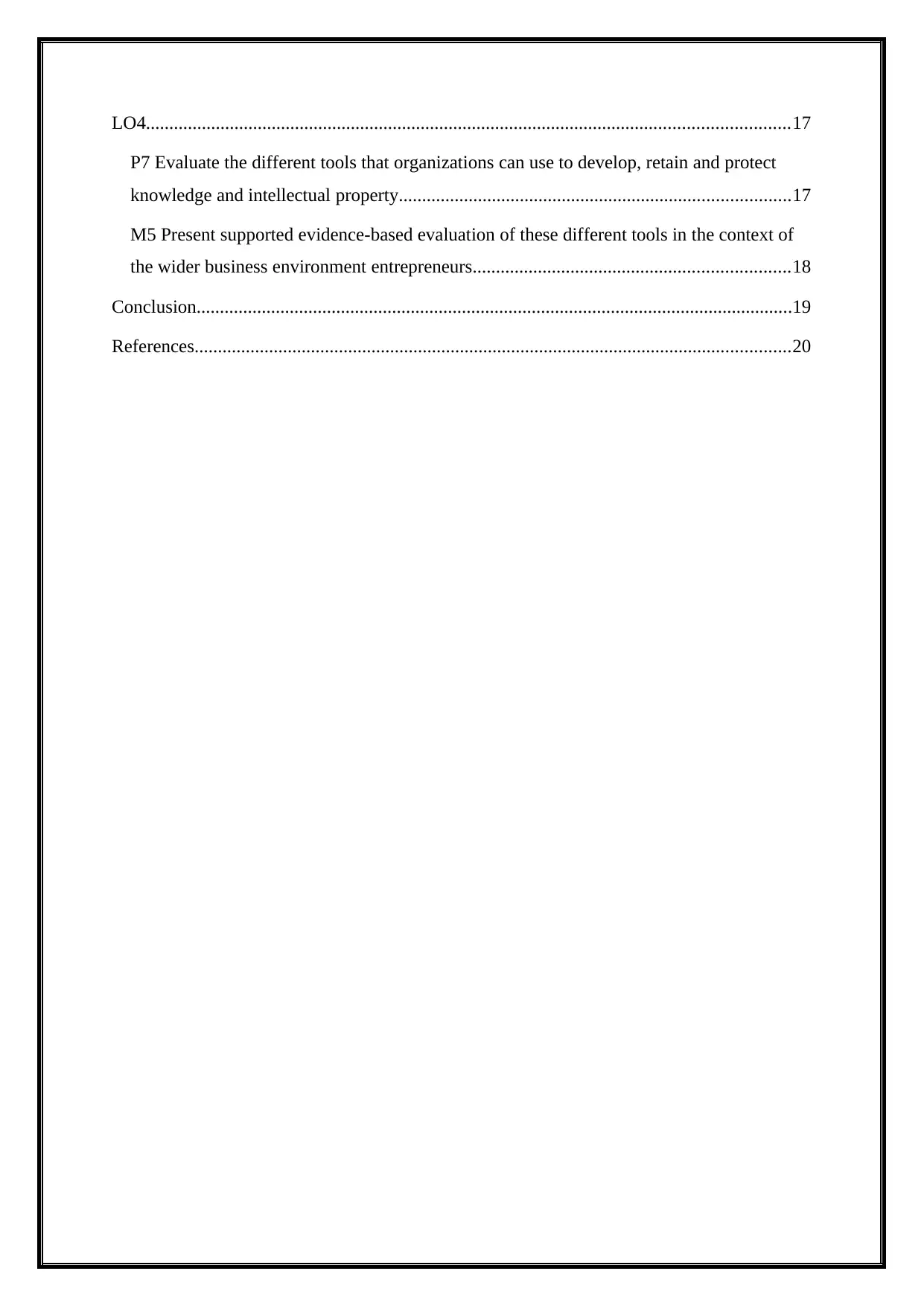
LO4..........................................................................................................................................17
P7 Evaluate the different tools that organizations can use to develop, retain and protect
knowledge and intellectual property....................................................................................17
M5 Present supported evidence-based evaluation of these different tools in the context of
the wider business environment entrepreneurs....................................................................18
Conclusion................................................................................................................................19
References................................................................................................................................20
P7 Evaluate the different tools that organizations can use to develop, retain and protect
knowledge and intellectual property....................................................................................17
M5 Present supported evidence-based evaluation of these different tools in the context of
the wider business environment entrepreneurs....................................................................18
Conclusion................................................................................................................................19
References................................................................................................................................20
⊘ This is a preview!⊘
Do you want full access?
Subscribe today to unlock all pages.

Trusted by 1+ million students worldwide
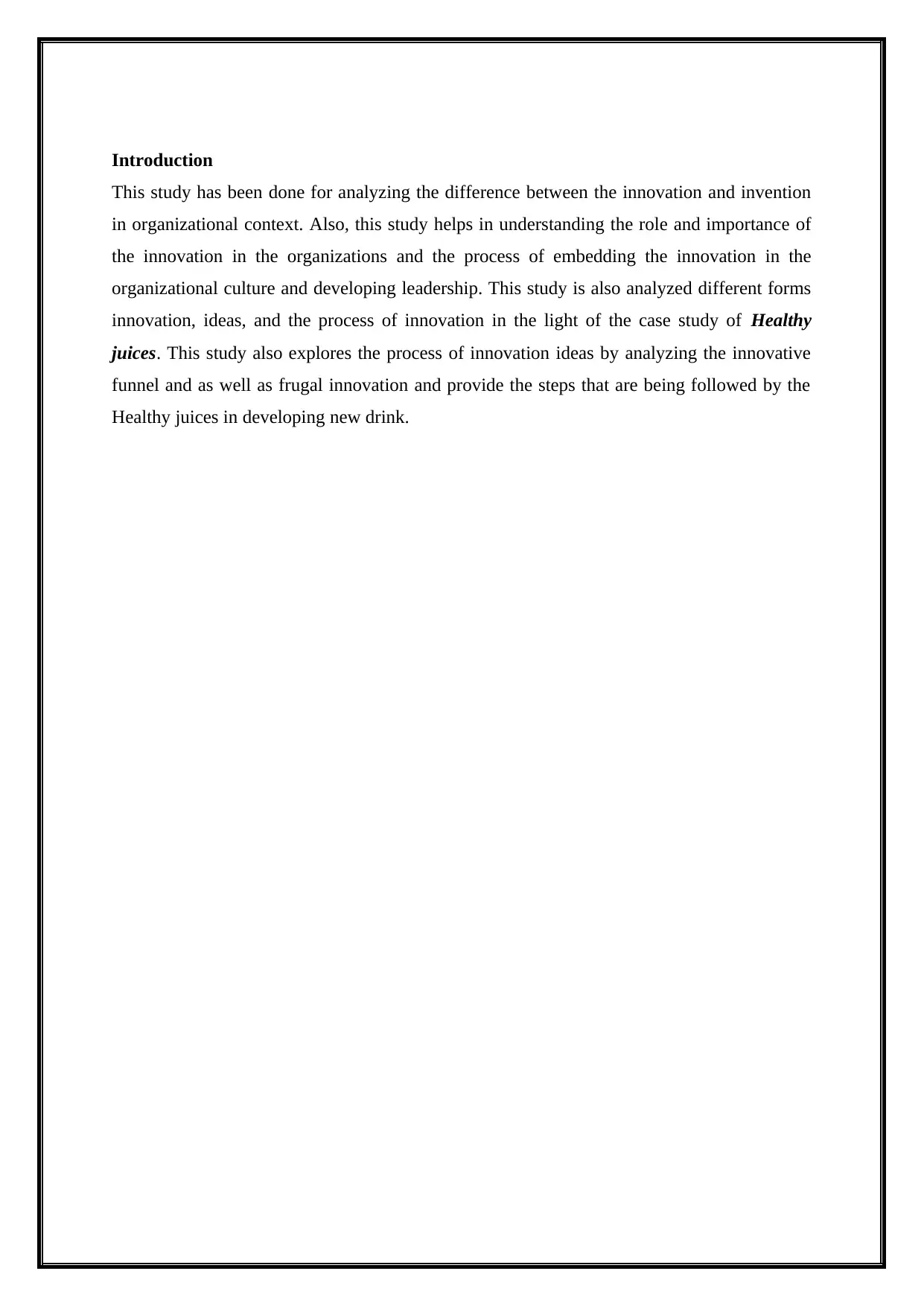
Introduction
This study has been done for analyzing the difference between the innovation and invention
in organizational context. Also, this study helps in understanding the role and importance of
the innovation in the organizations and the process of embedding the innovation in the
organizational culture and developing leadership. This study is also analyzed different forms
innovation, ideas, and the process of innovation in the light of the case study of Healthy
juices. This study also explores the process of innovation ideas by analyzing the innovative
funnel and as well as frugal innovation and provide the steps that are being followed by the
Healthy juices in developing new drink.
This study has been done for analyzing the difference between the innovation and invention
in organizational context. Also, this study helps in understanding the role and importance of
the innovation in the organizations and the process of embedding the innovation in the
organizational culture and developing leadership. This study is also analyzed different forms
innovation, ideas, and the process of innovation in the light of the case study of Healthy
juices. This study also explores the process of innovation ideas by analyzing the innovative
funnel and as well as frugal innovation and provide the steps that are being followed by the
Healthy juices in developing new drink.
Paraphrase This Document
Need a fresh take? Get an instant paraphrase of this document with our AI Paraphraser
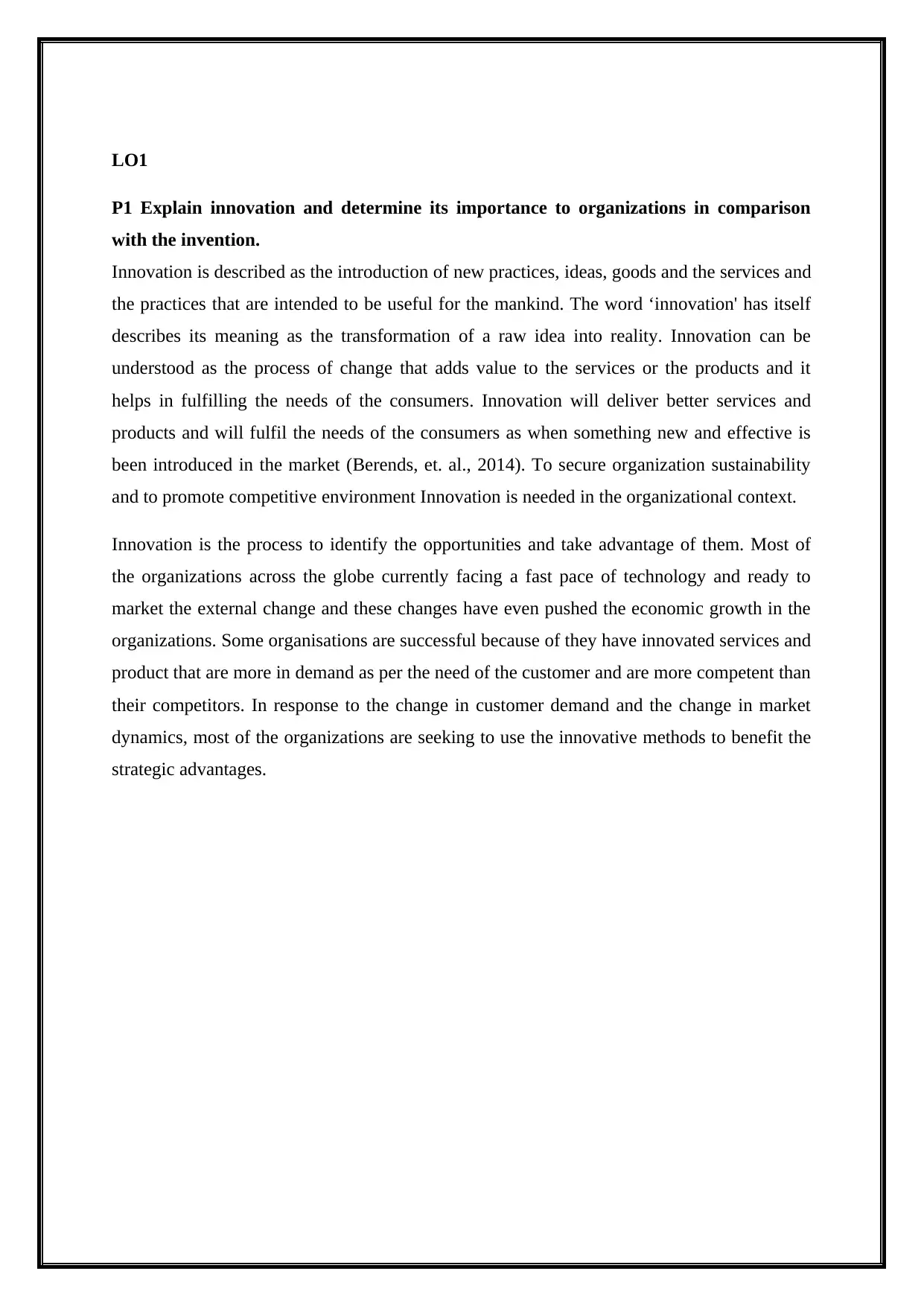
LO1
P1 Explain innovation and determine its importance to organizations in comparison
with the invention.
Innovation is described as the introduction of new practices, ideas, goods and the services and
the practices that are intended to be useful for the mankind. The word ‘innovation' has itself
describes its meaning as the transformation of a raw idea into reality. Innovation can be
understood as the process of change that adds value to the services or the products and it
helps in fulfilling the needs of the consumers. Innovation will deliver better services and
products and will fulfil the needs of the consumers as when something new and effective is
been introduced in the market (Berends, et. al., 2014). To secure organization sustainability
and to promote competitive environment Innovation is needed in the organizational context.
Innovation is the process to identify the opportunities and take advantage of them. Most of
the organizations across the globe currently facing a fast pace of technology and ready to
market the external change and these changes have even pushed the economic growth in the
organizations. Some organisations are successful because of they have innovated services and
product that are more in demand as per the need of the customer and are more competent than
their competitors. In response to the change in customer demand and the change in market
dynamics, most of the organizations are seeking to use the innovative methods to benefit the
strategic advantages.
P1 Explain innovation and determine its importance to organizations in comparison
with the invention.
Innovation is described as the introduction of new practices, ideas, goods and the services and
the practices that are intended to be useful for the mankind. The word ‘innovation' has itself
describes its meaning as the transformation of a raw idea into reality. Innovation can be
understood as the process of change that adds value to the services or the products and it
helps in fulfilling the needs of the consumers. Innovation will deliver better services and
products and will fulfil the needs of the consumers as when something new and effective is
been introduced in the market (Berends, et. al., 2014). To secure organization sustainability
and to promote competitive environment Innovation is needed in the organizational context.
Innovation is the process to identify the opportunities and take advantage of them. Most of
the organizations across the globe currently facing a fast pace of technology and ready to
market the external change and these changes have even pushed the economic growth in the
organizations. Some organisations are successful because of they have innovated services and
product that are more in demand as per the need of the customer and are more competent than
their competitors. In response to the change in customer demand and the change in market
dynamics, most of the organizations are seeking to use the innovative methods to benefit the
strategic advantages.
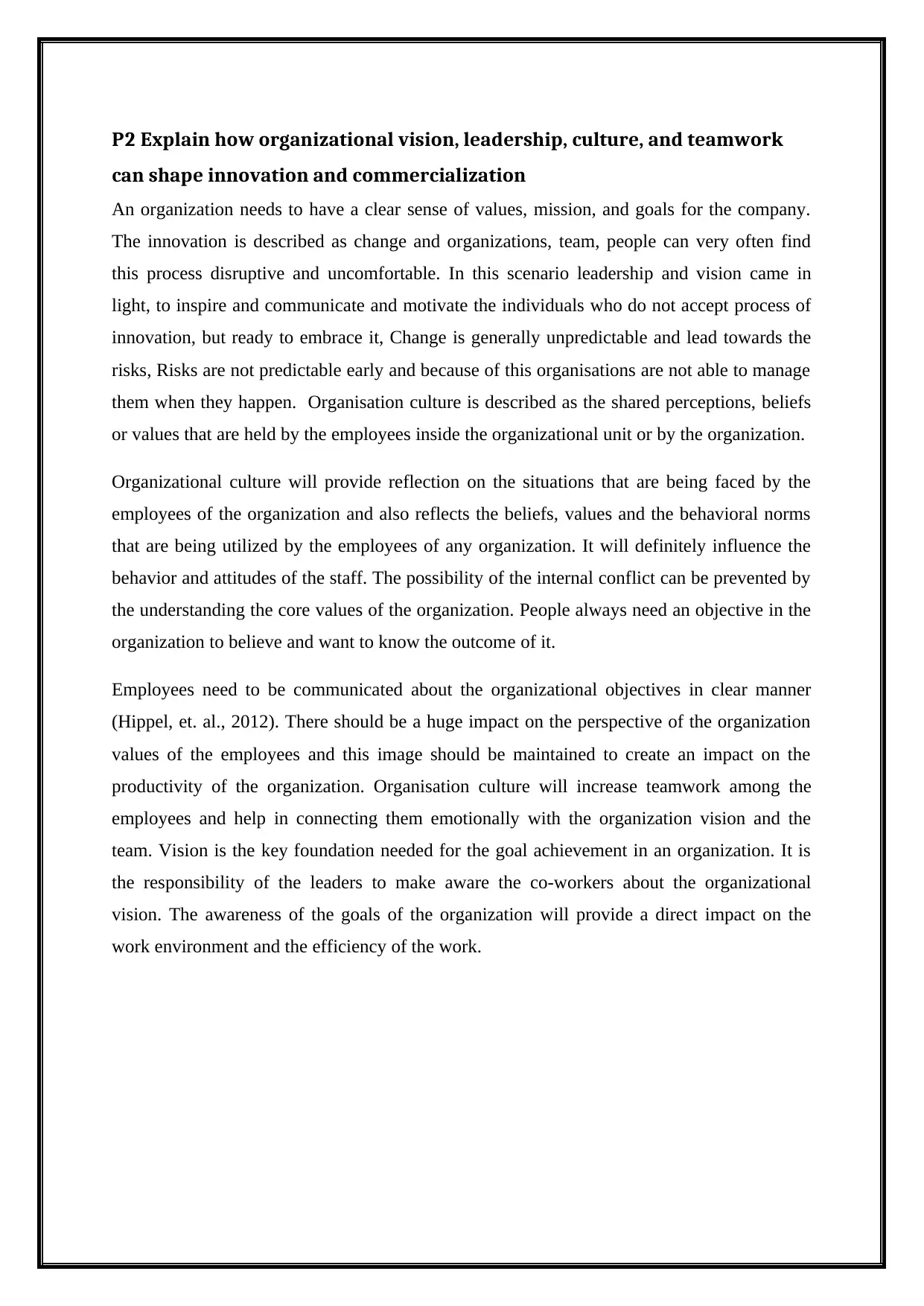
P2 Explain how organizational vision, leadership, culture, and teamwork
can shape innovation and commercialization
An organization needs to have a clear sense of values, mission, and goals for the company.
The innovation is described as change and organizations, team, people can very often find
this process disruptive and uncomfortable. In this scenario leadership and vision came in
light, to inspire and communicate and motivate the individuals who do not accept process of
innovation, but ready to embrace it, Change is generally unpredictable and lead towards the
risks, Risks are not predictable early and because of this organisations are not able to manage
them when they happen. Organisation culture is described as the shared perceptions, beliefs
or values that are held by the employees inside the organizational unit or by the organization.
Organizational culture will provide reflection on the situations that are being faced by the
employees of the organization and also reflects the beliefs, values and the behavioral norms
that are being utilized by the employees of any organization. It will definitely influence the
behavior and attitudes of the staff. The possibility of the internal conflict can be prevented by
the understanding the core values of the organization. People always need an objective in the
organization to believe and want to know the outcome of it.
Employees need to be communicated about the organizational objectives in clear manner
(Hippel, et. al., 2012). There should be a huge impact on the perspective of the organization
values of the employees and this image should be maintained to create an impact on the
productivity of the organization. Organisation culture will increase teamwork among the
employees and help in connecting them emotionally with the organization vision and the
team. Vision is the key foundation needed for the goal achievement in an organization. It is
the responsibility of the leaders to make aware the co-workers about the organizational
vision. The awareness of the goals of the organization will provide a direct impact on the
work environment and the efficiency of the work.
can shape innovation and commercialization
An organization needs to have a clear sense of values, mission, and goals for the company.
The innovation is described as change and organizations, team, people can very often find
this process disruptive and uncomfortable. In this scenario leadership and vision came in
light, to inspire and communicate and motivate the individuals who do not accept process of
innovation, but ready to embrace it, Change is generally unpredictable and lead towards the
risks, Risks are not predictable early and because of this organisations are not able to manage
them when they happen. Organisation culture is described as the shared perceptions, beliefs
or values that are held by the employees inside the organizational unit or by the organization.
Organizational culture will provide reflection on the situations that are being faced by the
employees of the organization and also reflects the beliefs, values and the behavioral norms
that are being utilized by the employees of any organization. It will definitely influence the
behavior and attitudes of the staff. The possibility of the internal conflict can be prevented by
the understanding the core values of the organization. People always need an objective in the
organization to believe and want to know the outcome of it.
Employees need to be communicated about the organizational objectives in clear manner
(Hippel, et. al., 2012). There should be a huge impact on the perspective of the organization
values of the employees and this image should be maintained to create an impact on the
productivity of the organization. Organisation culture will increase teamwork among the
employees and help in connecting them emotionally with the organization vision and the
team. Vision is the key foundation needed for the goal achievement in an organization. It is
the responsibility of the leaders to make aware the co-workers about the organizational
vision. The awareness of the goals of the organization will provide a direct impact on the
work environment and the efficiency of the work.
⊘ This is a preview!⊘
Do you want full access?
Subscribe today to unlock all pages.

Trusted by 1+ million students worldwide
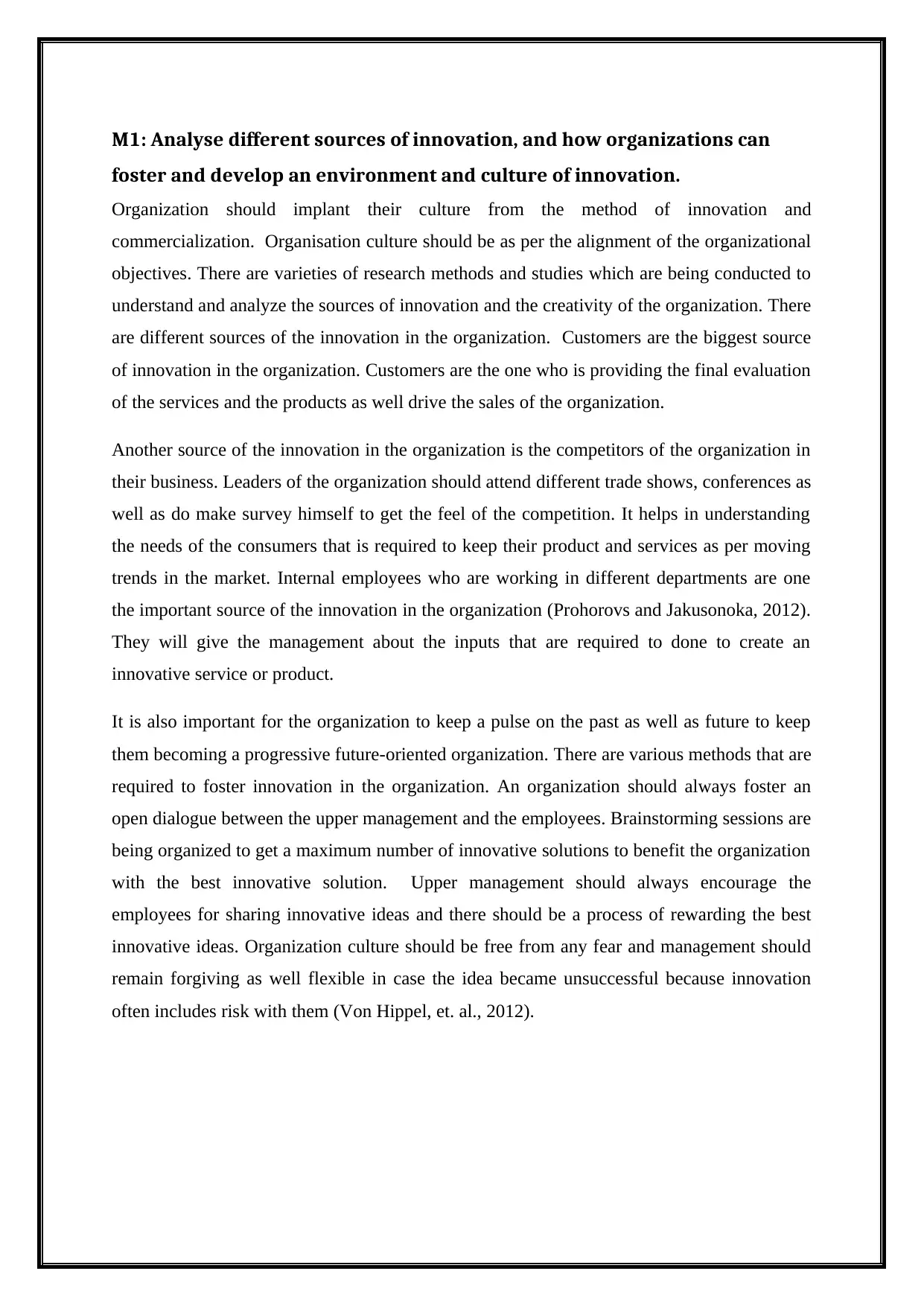
M1: Analyse different sources of innovation, and how organizations can
foster and develop an environment and culture of innovation.
Organization should implant their culture from the method of innovation and
commercialization. Organisation culture should be as per the alignment of the organizational
objectives. There are varieties of research methods and studies which are being conducted to
understand and analyze the sources of innovation and the creativity of the organization. There
are different sources of the innovation in the organization. Customers are the biggest source
of innovation in the organization. Customers are the one who is providing the final evaluation
of the services and the products as well drive the sales of the organization.
Another source of the innovation in the organization is the competitors of the organization in
their business. Leaders of the organization should attend different trade shows, conferences as
well as do make survey himself to get the feel of the competition. It helps in understanding
the needs of the consumers that is required to keep their product and services as per moving
trends in the market. Internal employees who are working in different departments are one
the important source of the innovation in the organization (Prohorovs and Jakusonoka, 2012).
They will give the management about the inputs that are required to done to create an
innovative service or product.
It is also important for the organization to keep a pulse on the past as well as future to keep
them becoming a progressive future-oriented organization. There are various methods that are
required to foster innovation in the organization. An organization should always foster an
open dialogue between the upper management and the employees. Brainstorming sessions are
being organized to get a maximum number of innovative solutions to benefit the organization
with the best innovative solution. Upper management should always encourage the
employees for sharing innovative ideas and there should be a process of rewarding the best
innovative ideas. Organization culture should be free from any fear and management should
remain forgiving as well flexible in case the idea became unsuccessful because innovation
often includes risk with them (Von Hippel, et. al., 2012).
foster and develop an environment and culture of innovation.
Organization should implant their culture from the method of innovation and
commercialization. Organisation culture should be as per the alignment of the organizational
objectives. There are varieties of research methods and studies which are being conducted to
understand and analyze the sources of innovation and the creativity of the organization. There
are different sources of the innovation in the organization. Customers are the biggest source
of innovation in the organization. Customers are the one who is providing the final evaluation
of the services and the products as well drive the sales of the organization.
Another source of the innovation in the organization is the competitors of the organization in
their business. Leaders of the organization should attend different trade shows, conferences as
well as do make survey himself to get the feel of the competition. It helps in understanding
the needs of the consumers that is required to keep their product and services as per moving
trends in the market. Internal employees who are working in different departments are one
the important source of the innovation in the organization (Prohorovs and Jakusonoka, 2012).
They will give the management about the inputs that are required to done to create an
innovative service or product.
It is also important for the organization to keep a pulse on the past as well as future to keep
them becoming a progressive future-oriented organization. There are various methods that are
required to foster innovation in the organization. An organization should always foster an
open dialogue between the upper management and the employees. Brainstorming sessions are
being organized to get a maximum number of innovative solutions to benefit the organization
with the best innovative solution. Upper management should always encourage the
employees for sharing innovative ideas and there should be a process of rewarding the best
innovative ideas. Organization culture should be free from any fear and management should
remain forgiving as well flexible in case the idea became unsuccessful because innovation
often includes risk with them (Von Hippel, et. al., 2012).
Paraphrase This Document
Need a fresh take? Get an instant paraphrase of this document with our AI Paraphraser

D1: Critically analyze how innovation is developed, embedded and
measured in an organizational context.
Innovation is described as a process that is best managed with the help of a long run
perspective. Innovation is measured with completion of the target goals rather than measuring
the long-term increments. As mentioned in the case study, that Mr. Green who has launched
the company with only one product and named the company as the healthy juice. He
measured that the sales are not as per the expectation because the company is only selling one
product a milkshake in the United Kingdom market. Since the launch of the product the sales
of the company has been increased significantly but after two years the consumers have loose
taste in the product and it has impacted the sales dramatically (Prohorovs and Jakusonoka,
2012). As the completion has been increased significantly across the UK market Mr. Green
thought that he should increase his product range with some more innovative products.
The healthy juice has diversified trade distribution which has been set up across the UK
market. It also analyse the success of the new ranges the company can run a physical survey
of the product by providing a chance to consumers to taste their drink in different crowded
areas by establishing temporary canopies and also can set canopies in their trade network
stores by seeking permission of the owners. It will help the company in analyzing results
priory and they can make the changes before the launching of the product. It is very
necessary for the organization to evaluate also the past performance of innovative idea that is
being implemented before presenting a future innovation critical to the success of the idea.
Innovation should always be developed by keeping in mind the customer need and
aspirations and also keep on the eye over the developments that are fostering in the market.
measured in an organizational context.
Innovation is described as a process that is best managed with the help of a long run
perspective. Innovation is measured with completion of the target goals rather than measuring
the long-term increments. As mentioned in the case study, that Mr. Green who has launched
the company with only one product and named the company as the healthy juice. He
measured that the sales are not as per the expectation because the company is only selling one
product a milkshake in the United Kingdom market. Since the launch of the product the sales
of the company has been increased significantly but after two years the consumers have loose
taste in the product and it has impacted the sales dramatically (Prohorovs and Jakusonoka,
2012). As the completion has been increased significantly across the UK market Mr. Green
thought that he should increase his product range with some more innovative products.
The healthy juice has diversified trade distribution which has been set up across the UK
market. It also analyse the success of the new ranges the company can run a physical survey
of the product by providing a chance to consumers to taste their drink in different crowded
areas by establishing temporary canopies and also can set canopies in their trade network
stores by seeking permission of the owners. It will help the company in analyzing results
priory and they can make the changes before the launching of the product. It is very
necessary for the organization to evaluate also the past performance of innovative idea that is
being implemented before presenting a future innovation critical to the success of the idea.
Innovation should always be developed by keeping in mind the customer need and
aspirations and also keep on the eye over the developments that are fostering in the market.

LO2
P3: Explain the 4Ps of innovation and explain the use of the innovation funnel to
examine and shape innovative ideas
The 4 Ps model of innovation is developed by the Joe Tidd in association with John Bessant.
This is one of the most powerful methods for analysis. There are four main categories in the
4Ps model of innovation as described below:
Product Innovation: Product or services is everything that is being offered by the
organization. An organization or the firms existed because of the products or the services
they are being offered. In the mentioned case of Healthy juice, the company has
innovated a product such as a milkshake that is being liked by the consumers and found it
an innovative product.
Process Innovation: This stage describes the method with the help of which the
organizations will create the product or service from the business idea. It includes every
aspect that is involved in from the innovation of the product or services to reaching the
services or products in the hands of the consumers. In the case of healthy juice, the
company has created an innovative product and establishes a diversified business network
for delivering the products up to the last mile and finally on to the hands of consumers
(Kotsemir and Meissner, 2013).
A position of Innovation: In this stage, the focus is given to the positioning of the
product or service. It is the process by which the organization will create the perception in
the minds of the consumers. Healthy juices has innovate a product that is perceived as a
health benefit for its users and also the company a positioned itself as the makers of the
health drink. It is positioning statement of the company because of which they are
planning to increase its product range.
Paradigm Innovation: This is the last stage of the innovation where the company is
focusing on the primary mental models change (Kotsemir and Meissner, 2013). Paradigm
innovation revolves around the three important terms why, How, and what. It is the
analysis of the basic objective behind the launch of the innovative product.
Developing an innovation funnel is involving three primary steps.
P3: Explain the 4Ps of innovation and explain the use of the innovation funnel to
examine and shape innovative ideas
The 4 Ps model of innovation is developed by the Joe Tidd in association with John Bessant.
This is one of the most powerful methods for analysis. There are four main categories in the
4Ps model of innovation as described below:
Product Innovation: Product or services is everything that is being offered by the
organization. An organization or the firms existed because of the products or the services
they are being offered. In the mentioned case of Healthy juice, the company has
innovated a product such as a milkshake that is being liked by the consumers and found it
an innovative product.
Process Innovation: This stage describes the method with the help of which the
organizations will create the product or service from the business idea. It includes every
aspect that is involved in from the innovation of the product or services to reaching the
services or products in the hands of the consumers. In the case of healthy juice, the
company has created an innovative product and establishes a diversified business network
for delivering the products up to the last mile and finally on to the hands of consumers
(Kotsemir and Meissner, 2013).
A position of Innovation: In this stage, the focus is given to the positioning of the
product or service. It is the process by which the organization will create the perception in
the minds of the consumers. Healthy juices has innovate a product that is perceived as a
health benefit for its users and also the company a positioned itself as the makers of the
health drink. It is positioning statement of the company because of which they are
planning to increase its product range.
Paradigm Innovation: This is the last stage of the innovation where the company is
focusing on the primary mental models change (Kotsemir and Meissner, 2013). Paradigm
innovation revolves around the three important terms why, How, and what. It is the
analysis of the basic objective behind the launch of the innovative product.
Developing an innovation funnel is involving three primary steps.
⊘ This is a preview!⊘
Do you want full access?
Subscribe today to unlock all pages.

Trusted by 1+ million students worldwide
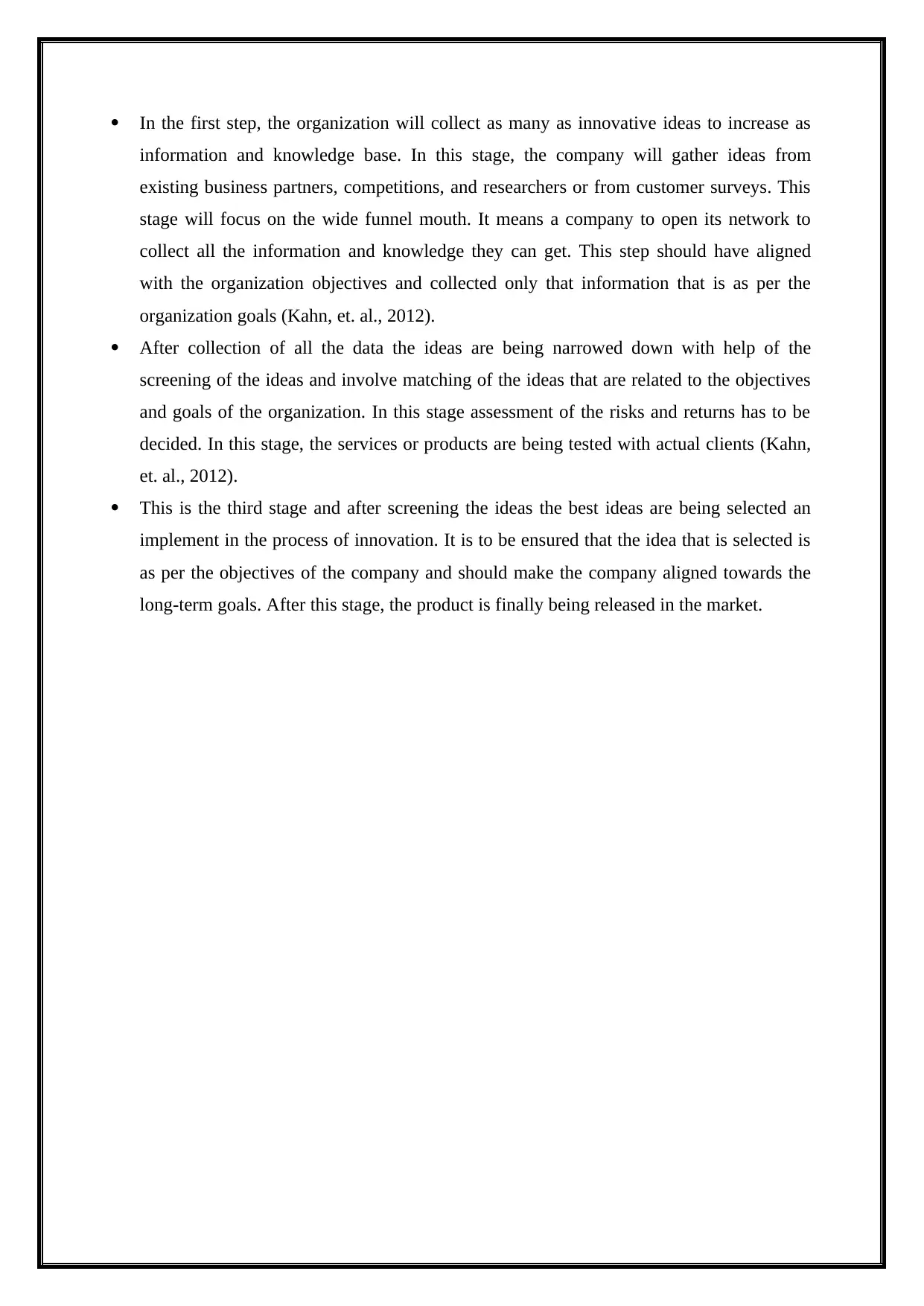
In the first step, the organization will collect as many as innovative ideas to increase as
information and knowledge base. In this stage, the company will gather ideas from
existing business partners, competitions, and researchers or from customer surveys. This
stage will focus on the wide funnel mouth. It means a company to open its network to
collect all the information and knowledge they can get. This step should have aligned
with the organization objectives and collected only that information that is as per the
organization goals (Kahn, et. al., 2012).
After collection of all the data the ideas are being narrowed down with help of the
screening of the ideas and involve matching of the ideas that are related to the objectives
and goals of the organization. In this stage assessment of the risks and returns has to be
decided. In this stage, the services or products are being tested with actual clients (Kahn,
et. al., 2012).
This is the third stage and after screening the ideas the best ideas are being selected an
implement in the process of innovation. It is to be ensured that the idea that is selected is
as per the objectives of the company and should make the company aligned towards the
long-term goals. After this stage, the product is finally being released in the market.
information and knowledge base. In this stage, the company will gather ideas from
existing business partners, competitions, and researchers or from customer surveys. This
stage will focus on the wide funnel mouth. It means a company to open its network to
collect all the information and knowledge they can get. This step should have aligned
with the organization objectives and collected only that information that is as per the
organization goals (Kahn, et. al., 2012).
After collection of all the data the ideas are being narrowed down with help of the
screening of the ideas and involve matching of the ideas that are related to the objectives
and goals of the organization. In this stage assessment of the risks and returns has to be
decided. In this stage, the services or products are being tested with actual clients (Kahn,
et. al., 2012).
This is the third stage and after screening the ideas the best ideas are being selected an
implement in the process of innovation. It is to be ensured that the idea that is selected is
as per the objectives of the company and should make the company aligned towards the
long-term goals. After this stage, the product is finally being released in the market.
Paraphrase This Document
Need a fresh take? Get an instant paraphrase of this document with our AI Paraphraser

P4 Explain developments in frugal innovation and provide examples of how it is used in
an organizational context.
Frugal innovation is the process of engineering that is reducing the production cost of the
services or products and significantly reduce the complexity of the cost of the goods. This
innovation process has been implemented in the different market scenario as per the
customized need of the market. Frugal innovation is the reducing the use of scarce resources
as well as generating more business and the social value. There are various developments
stages in the process of frugal innovation stages (Ferreira, et. al., 2015).
The first stage is the identification of the problem by analyzing the market as per the
customer needs and then after screening of the ideas as per the 4Ps model, an idea has
transformed into the product. Frugal innovation is the form of a customized version of an
innovated product that is available as per the requirement and the dynamics of the market. As
per the case mentioned here, the frugal innovation can be used in the healthy juice company
by launching the different flavors of the customers as per the identification of the needs of the
customers and also analyzing the affordability of the customers. Even the customers can
reduce or increase the range as per the needs of the market and make the decision as per
analyzing the competition as well (Ferreira, et. al., 2015).
an organizational context.
Frugal innovation is the process of engineering that is reducing the production cost of the
services or products and significantly reduce the complexity of the cost of the goods. This
innovation process has been implemented in the different market scenario as per the
customized need of the market. Frugal innovation is the reducing the use of scarce resources
as well as generating more business and the social value. There are various developments
stages in the process of frugal innovation stages (Ferreira, et. al., 2015).
The first stage is the identification of the problem by analyzing the market as per the
customer needs and then after screening of the ideas as per the 4Ps model, an idea has
transformed into the product. Frugal innovation is the form of a customized version of an
innovated product that is available as per the requirement and the dynamics of the market. As
per the case mentioned here, the frugal innovation can be used in the healthy juice company
by launching the different flavors of the customers as per the identification of the needs of the
customers and also analyzing the affordability of the customers. Even the customers can
reduce or increase the range as per the needs of the market and make the decision as per
analyzing the competition as well (Ferreira, et. al., 2015).
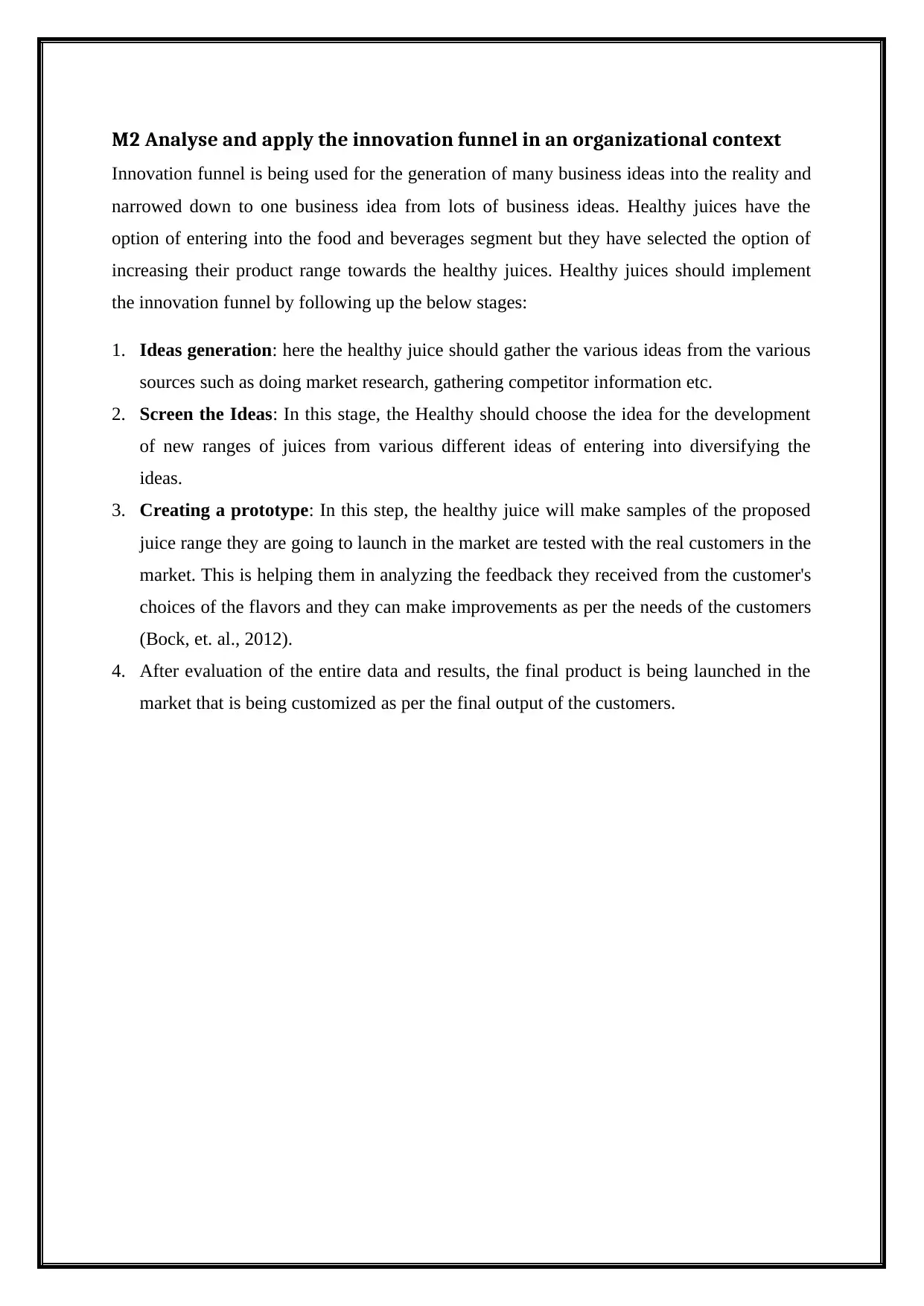
M2 Analyse and apply the innovation funnel in an organizational context
Innovation funnel is being used for the generation of many business ideas into the reality and
narrowed down to one business idea from lots of business ideas. Healthy juices have the
option of entering into the food and beverages segment but they have selected the option of
increasing their product range towards the healthy juices. Healthy juices should implement
the innovation funnel by following up the below stages:
1. Ideas generation: here the healthy juice should gather the various ideas from the various
sources such as doing market research, gathering competitor information etc.
2. Screen the Ideas: In this stage, the Healthy should choose the idea for the development
of new ranges of juices from various different ideas of entering into diversifying the
ideas.
3. Creating a prototype: In this step, the healthy juice will make samples of the proposed
juice range they are going to launch in the market are tested with the real customers in the
market. This is helping them in analyzing the feedback they received from the customer's
choices of the flavors and they can make improvements as per the needs of the customers
(Bock, et. al., 2012).
4. After evaluation of the entire data and results, the final product is being launched in the
market that is being customized as per the final output of the customers.
Innovation funnel is being used for the generation of many business ideas into the reality and
narrowed down to one business idea from lots of business ideas. Healthy juices have the
option of entering into the food and beverages segment but they have selected the option of
increasing their product range towards the healthy juices. Healthy juices should implement
the innovation funnel by following up the below stages:
1. Ideas generation: here the healthy juice should gather the various ideas from the various
sources such as doing market research, gathering competitor information etc.
2. Screen the Ideas: In this stage, the Healthy should choose the idea for the development
of new ranges of juices from various different ideas of entering into diversifying the
ideas.
3. Creating a prototype: In this step, the healthy juice will make samples of the proposed
juice range they are going to launch in the market are tested with the real customers in the
market. This is helping them in analyzing the feedback they received from the customer's
choices of the flavors and they can make improvements as per the needs of the customers
(Bock, et. al., 2012).
4. After evaluation of the entire data and results, the final product is being launched in the
market that is being customized as per the final output of the customers.
⊘ This is a preview!⊘
Do you want full access?
Subscribe today to unlock all pages.

Trusted by 1+ million students worldwide
1 out of 22
Related Documents
Your All-in-One AI-Powered Toolkit for Academic Success.
+13062052269
info@desklib.com
Available 24*7 on WhatsApp / Email
![[object Object]](/_next/static/media/star-bottom.7253800d.svg)
Unlock your academic potential
Copyright © 2020–2025 A2Z Services. All Rights Reserved. Developed and managed by ZUCOL.




